How to NFT 6: Games
Games are always monopolized in the hands of centralized corporate entities, and game developers or publishers have strict restrictions on the virtual economy in games.
Players cannot freely trade their in-game items and assets, and usually need to illegally use third-party platforms, relying on unsafe P2P transactions to complete. More importantly, the digital assets in the game are owned and controlled by the developer.
While most players may be happy with the status quo, there's no denying that limitations exist. A lot of gamers value their virtual assets, but if game developers have the right to take those assets from you, can you really say you own them? Virtual interaction between games is also limited from a technical standpoint, with items of value locked into a specific game, with the exception of perhaps large, long-running franchises with strong development teams (e.g. Pokémon).
Now imagine a digital world where games are interoperable and players can move characters, assets, and currencies between each other. If you've seen the movie Ready Player One (or even read the book), you probably can relate to the idea of this game. exist"traditional game"Among them, one example we can think of is Pokémon, a mobile application that facilitates the transfer of Pokémon between different Pokémon series and Nintendo consoles through cloud computing.
However, the problem with Pokémon (and all games in general) is:
1. The interoperability of games is limited to the "Pokémon" series, not other games
2. Creating assets out of thin air is a very common phenomenon
3. Player autonomy is still limited by developers
4. There is no (legal) way to sell assets for cash or other virtual assets.
recognize"traditional game"Despite the limitations of blockchain technology, developers are using blockchain technology to build games that allow players greater freedom and autonomy over in-game items and currencies. A big part of this process involves creating NFTs and tokens to represent digital assets and in-game currencies. This may not seem like a big deal, but its impact is bigger than you might think.
Once in-game currencies and items are deployed as tokens and NFTs, they can be purchased on decentralized exchanges (DEXs) and NFT marketplaces. In other words, players can freely trade and exchange these items for other cryptocurrencies such as Dai, USDC Coin, ETH, and even other game assets. This is a result of greater player autonomy, as NFTs provide true ownership, allowing players to do anything with assets.
At the same time, due to the security provided by the blockchain, it also limits asset hacking, that is, creating new assets out of thin air. Nonetheless, it should be noted that other forms of hacking can still occur if there are flaws in the smart contract (eg infinite coinage) or the game itself (eg map hacking, infinite energy generation, etc.).
earn while playing"earn while playing"secondary title
Axie Infinity
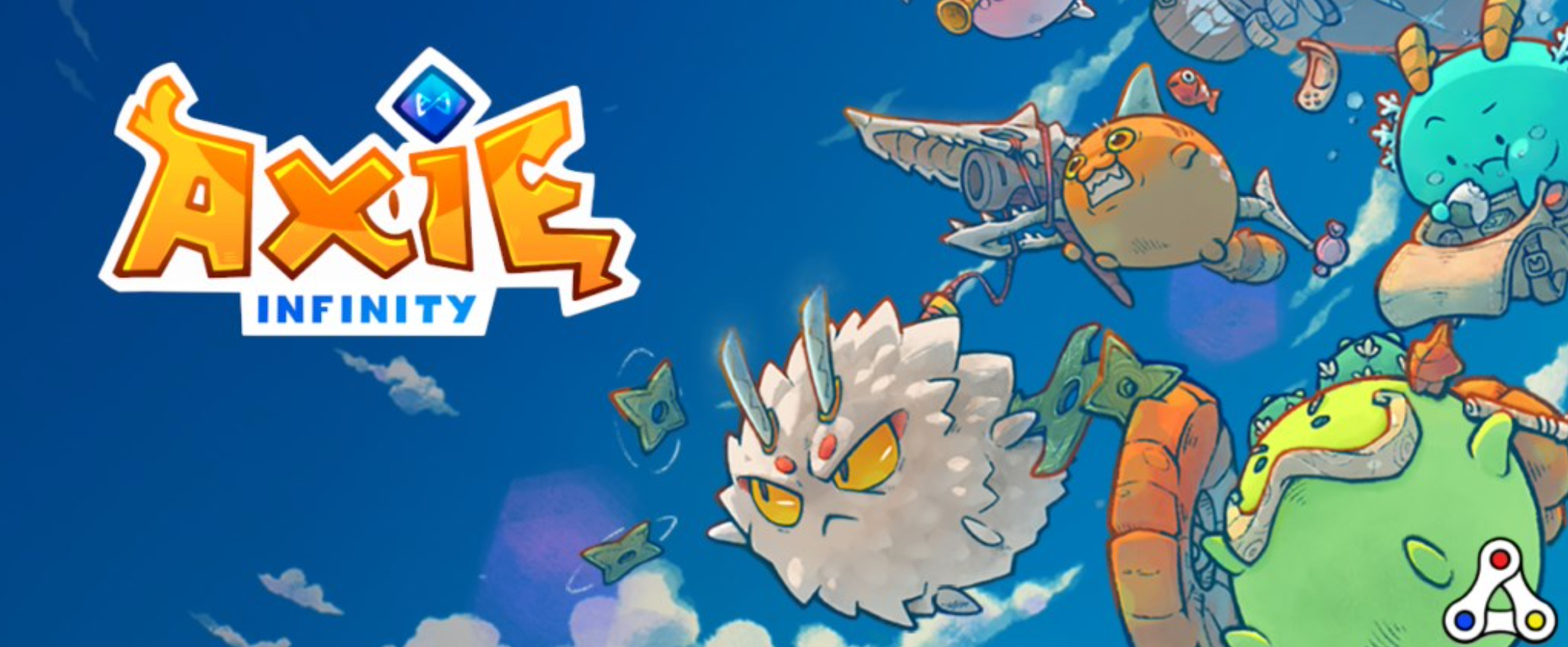
As early as 2018, Acra was developed by Sky Mavis Game Studio. In the game, the virtual pet crab and the virtual land are represented in the form of NFT. These NFTs are primarily traded on Ronin, Sky Mavis’ own ethereum sidechain.
Acra has become very popular in many developing countries due to its play-to-earn (P2E) model. P2E refers to the gaming concept where players earn in-game tokens after completing certain tasks or achievements. These game tokens can also be transferred out of the game and into wallets or exchanges where they can be exchanged for various other currencies for use in the real world.
In May 2021, Ah Crab released a mini-documentary about the game's growing player base in the Philippines. A crab"earn while playing"The model provides an income stream for players of many different age groups, including those affected by the new crown virus.
Crab borrows many elements from "Pokemon", including the cultivation system of skill cards and states (similar to "Pokemon"'s actions and IV states). The gameplay of the game can be roughly divided into two parts, namely PVE and PVP. In PVE, players play against bots, but in PVP, players play against each other.
Whether it is PVP or PVE mode, players must bring three pets to participate. Each pet has four skills, and pets are randomly selected to release skills in each round. There are over 100 different skills and 9 pets. A crab also has a station and energy consumption mechanism.
Unlike most blockchain-based games, Acra works on both Android and Apple devices. These applications are all running under the same server. Users can play freely with one account on all devices. Users must have a Ronin wallet to acquire and breed pets.
Axie has two tokens, Axie Infinity Shard (AXS) and Smooth Love Potion (SLP). Both tokens are necessary to breed pets. A pet can be bred up to 7 times. The cost of reproduction is 1 AXS + a certain amount of SLP (depending on the number of reproductions of both parents). For example, if one of the parents reproduced 0 times and the other reproduced 2 times, the total SLP cost would be 2100 SLP.
secondary title
Cometh

Players in Cometh (also known as space miners) control spaceships, which are NFTs issued on the Horseshoe Chain. They orbit the giant star in a circular trajectory and their main goal is to mine coins from the asteroid.
The initial parameters of the spacecraft trajectory are randomly drawn from the hash of the block in which it was created. One spacecraft could be pulled toward another in space to approach another intelligent asteroid.
Spaceships can be upgraded with other NFTs, such as better drilling tools, engines, or crew, which can improve the mining ability of the spaceship and let you get more income.
Traction is the core mechanic of Cometh. Other players can pay the ship for the towing service and pay the ship owner, who is free to set and change the fees they charge. The ultimate goal is to tug your ship close enough to the asteroid's trajectory, and earn a reward.
Smart asteroids are smart contracts that represent asteroids in the game. Like Kepler's first law in the real world, smart asteroids have an elliptical trajectory around the star they orbit. The trajectory parameters of the smart asteroid are randomly drawn from the block hash where the asteroid appeared.
The creation of new intelligent asteroids is a process left to the Cometh Generator. It is a smart contract that accumulates returns based on Ethereum assets (eg, liquidity pool tokens). Miners can mine asteroids and earn income.
In Cometh V1, these assets are accumulated as part of earning fees from ComethSwap, Cometh’s own DEX built on top of the game. However, in Cometh v2 (Cometh: Beyond), the developers plan to introduce a new fee earning system that will be released in the upcomingsecondary title。
Gods Unchained
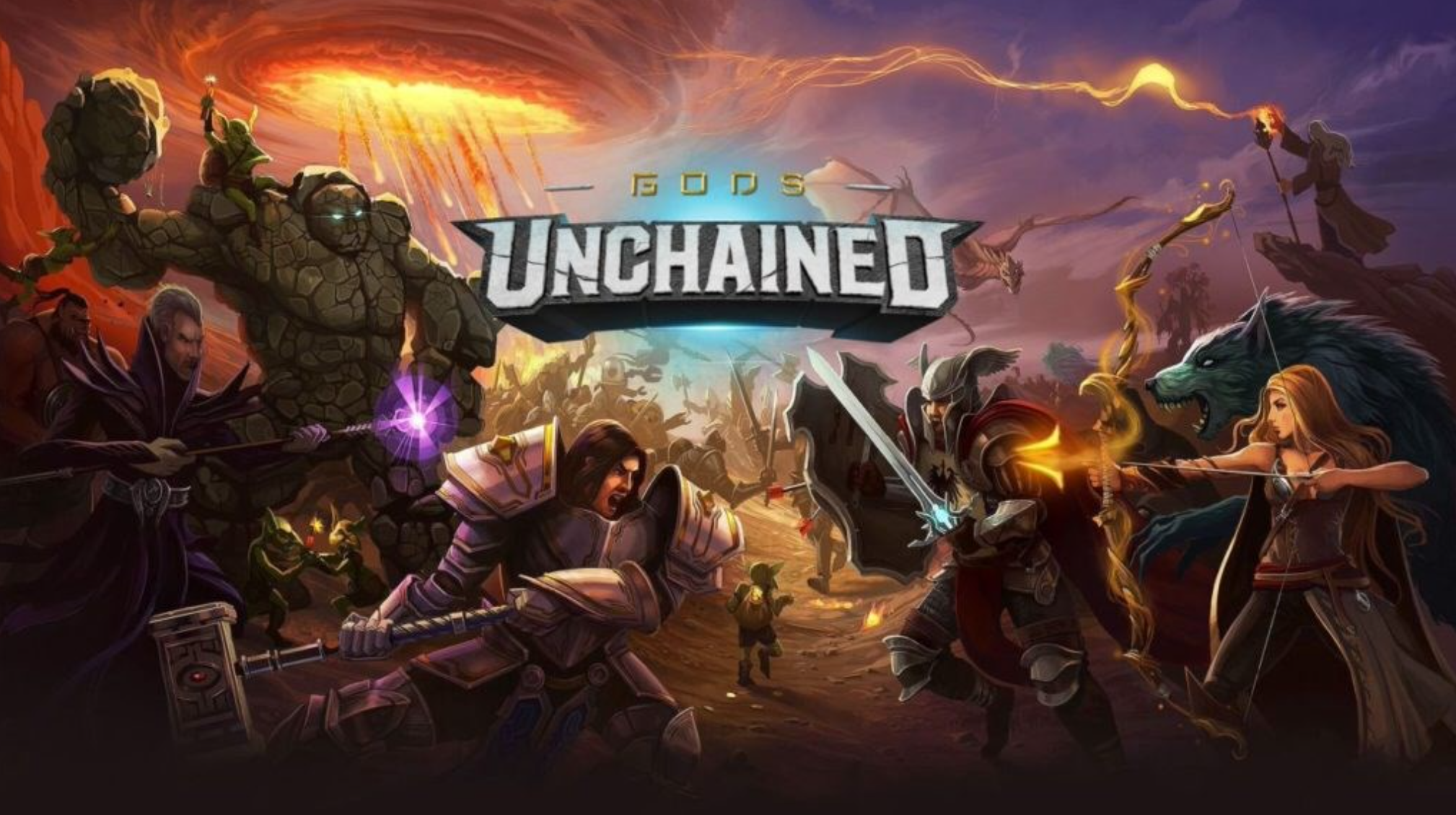
Gods Unchained is a free-to-play tactical card game launched in 2019. Its gameplay is very similar to Hearthstone. Led by the former game director of Magic: The Gathering Arena, the game's focus on competitive play means players must strategically outmaneuver their opponents by building decks that can counter a variety of tactics.
In Gods Unchained, players fully own their digital items, mainly in the form of trading cards in the form of NFT, and players can freely buy, sell and use their cards - just like players actually own a physical card. There are several modes to choose from in the game. The single player mode pits you against a computer opponent and is designed to allow players to train and test new decks. Build mode lets you play against players online, and players gain experience points, level up, and unlock new cards through battles.
If you are a player who wants to continuously improve the level, you can go to the ladder mode (Ranked Constructed). In addition to gaining experience in this mode, players can also unlock prizes and earn Flux (the native token), which provides crafting functionality in Gauntlet of Gods.
To welcome new users, new players get 2 copies of 70 different cards, for a total of 140 cards. These pre-made decks are designed to ease new players into the game by sharing the different traits and strategies each of the six gods (types) offers. In addition, base cards (called core cards) are provided.
first level title
Earn while you play (P2E)
As the name suggests, P2E is to allow players to earn income by playing games. Depending on the game, there are different economies, strategies and methods to build a solid income.
A typical example is that selling resources in the game takes a lot of time. Players who don't want to spend a lot of time but still want to have a good gaming experience are usually willing to pay for it.
P2E actually existed before the emergence of blockchain games.Runescape, a hugely popular massively multiplayer online role-playing game (MMORPG) released by Jagex in 2001, has been a major source of income for many Venezuelans over the past few years.
P2E players need to rely on third-party platforms to trade and sell their game currency. These platforms are often illegal because they are not licensed by the game developer and violate the terms of the game.
first level title
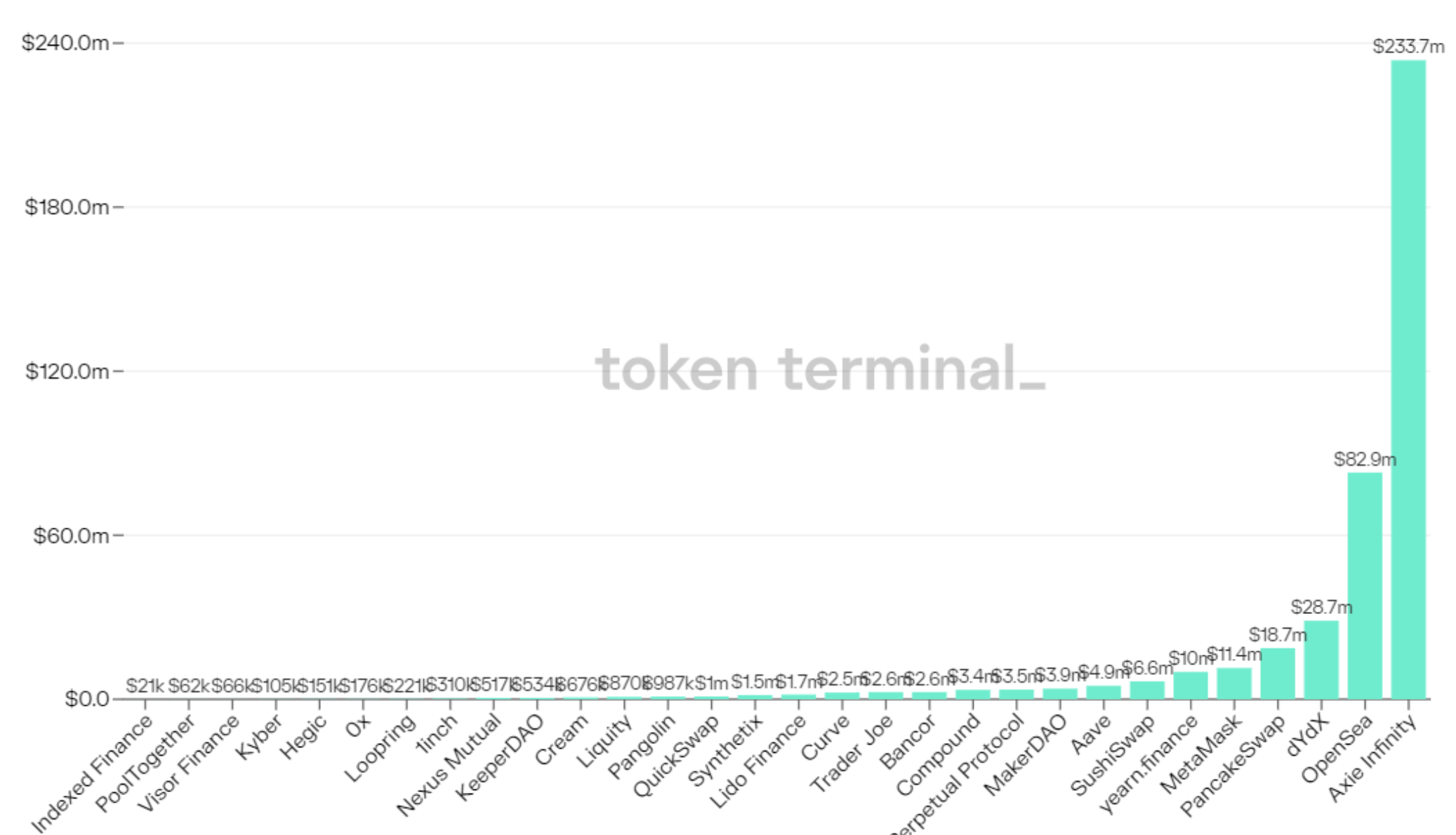
Case Study: Ah Crab
A crab's success is mainly due to its strong P2E effect. There are currently four main ways Acra players can earn money through the game.
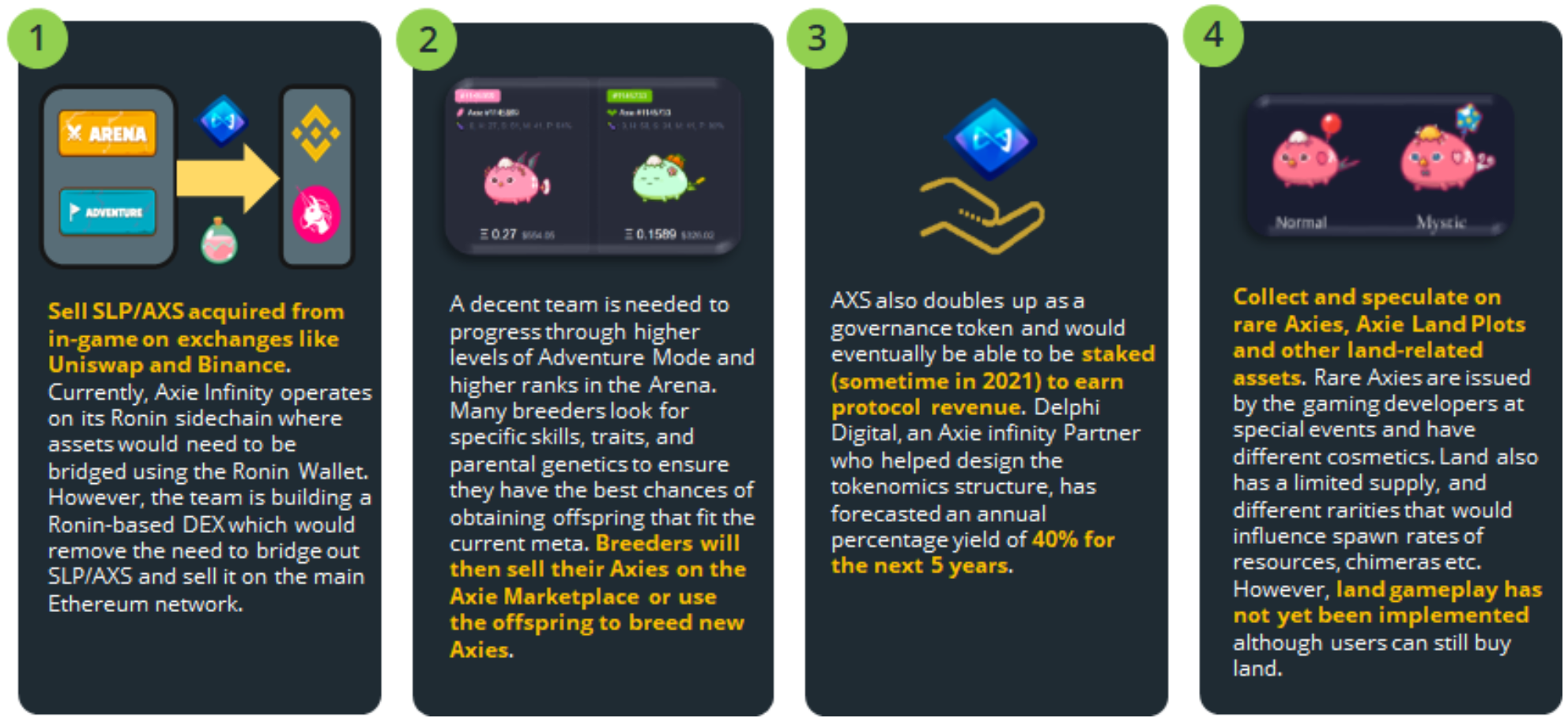
To really get a sense of how profitable playing Axie is, here's a typical Axie player's day job farming SLP using method 1 (the most popular option). We tested the game ourselves and came up with an approximation of the base case.
game notes
Players get the token SLP from the competition, and each entry requires 1 energy. A team of 3 crabs (minimum requirement) can get 20 energy per day.
Earning SLP in Adventure Mode does not require Energy. But pets need energy to gain experience points, and experience points can improve pet attributes. We'll assume an average of 10 energy is spent per day to level up.
This leaves 10 energy left to use in the arena. Depending on your level matching match (MMR), you will get a different amount of SLP tokens. Note that you can only get SLP if you win. We'll assume 15 SLP is awarded per game (average SLP earned from a 1550-1650 MMR rating) for winning 5 games per day.
Winning 10 games in Adventure Mode and 5 games in Arena Mode will earn you 25 SLP as part of your daily quest rewards.
Estimated daily SLP rewards
Adventure Mode = 50 SLP
Arena Mode = 75 SLP
Daily Quests = 25 SLP
Total SLP Earned = 150SLP
Estimated call time
According to our own experience, a crab game lasts about 5 minutes. You need 100 minutes to clear all 20 games. If we include break times, load times, and games played in adventure mode (before hitting the 75SLP cap), we get roughly 4 hours a day in the game.
reward comparison
Based on these assumptions, if the SLP price is $0.1, below is a calculation of the income of a crab player, compared to minimum wage jobs in selected countries (before taxes).
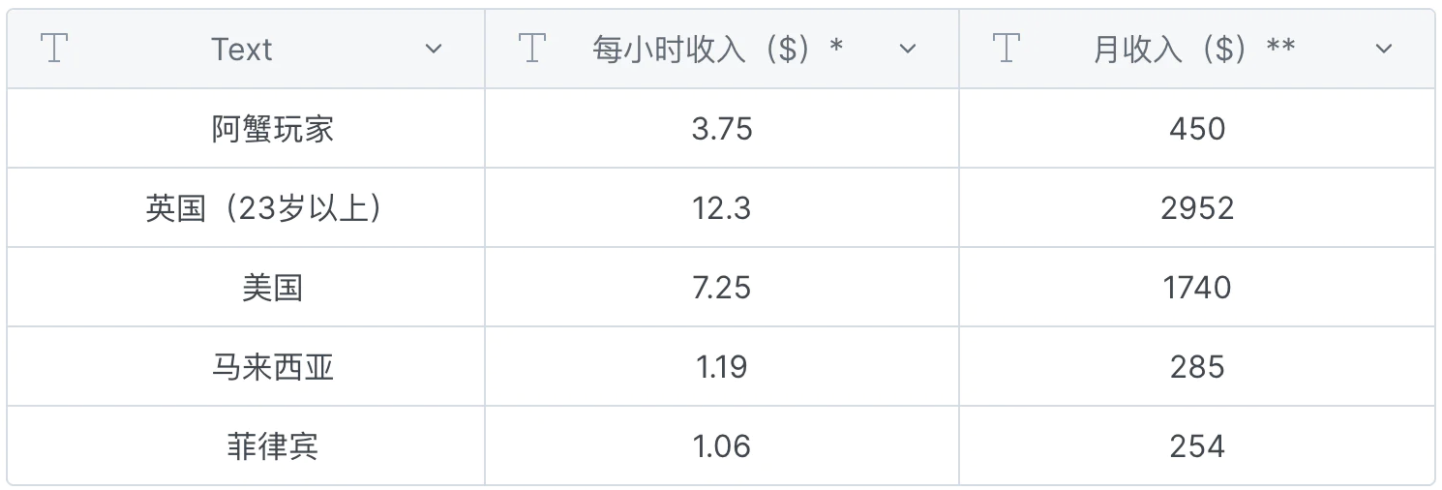
*Daily earnings for each country are based on their respective minimum wages. Data sources are gov.uk, US Department of Labor and ASEAN Briefing.
**Monthly earnings rate is based on 8 hour shifts, except for crab players, capped at 20 energy per day.
Note that this is the yield in the base case only. Players with 20 pets or more have 60 energy per day. While Adventure Mode is capped at 75 SLP, players will be able to take advantage of more opportunities to earn SLP in the Arena. Not to mention tournaments and regular seasons, AXS and SLP rewards are distributed to top ranked players.
Anyway, considering it only takes about 4 hours a day, earning $450 a month is a lot by Southeast Asian standards. Remember, playing Acra is not a job, it's a game. People are being rewarded handsomely just by playing a game whose ultimate purpose is entertainment!
Not everyone can afford a pet team of crabs, however. As of November 2021, the average base price for a single crab pet is $115. One needs to invest about $345 up front and meet the minimum requirement of 3 pets to play. This is a considerable amount, especially for players in developing countries who lack a basic income.
To solve this problem, Acra officially allows the rental of Acra pets through their system. Sponsors can loan crab pets by sharing their Mavis Hub password with students. Trainees have no control over these assets as they are tied to the owner's wallet, but players can use pets to play the game.
Note: It should be noted that although the assets are safe, there is still a trust issue between the sponsor and the students, because the sponsor has the ultimate control over the SLP earnings in the wallet: the students must trust that the sponsor will follow their agreement Conditional distribution of SLP.
In return, the trainees sign a profit-sharing agreement, whereby the SLP earned in the game is shared between both parties. This spawned a whole new"employment"Category, that is, the crab scholarship. Some trainees even have resumes.
Note: A student is a player who rents a crab pet from a sponsor.
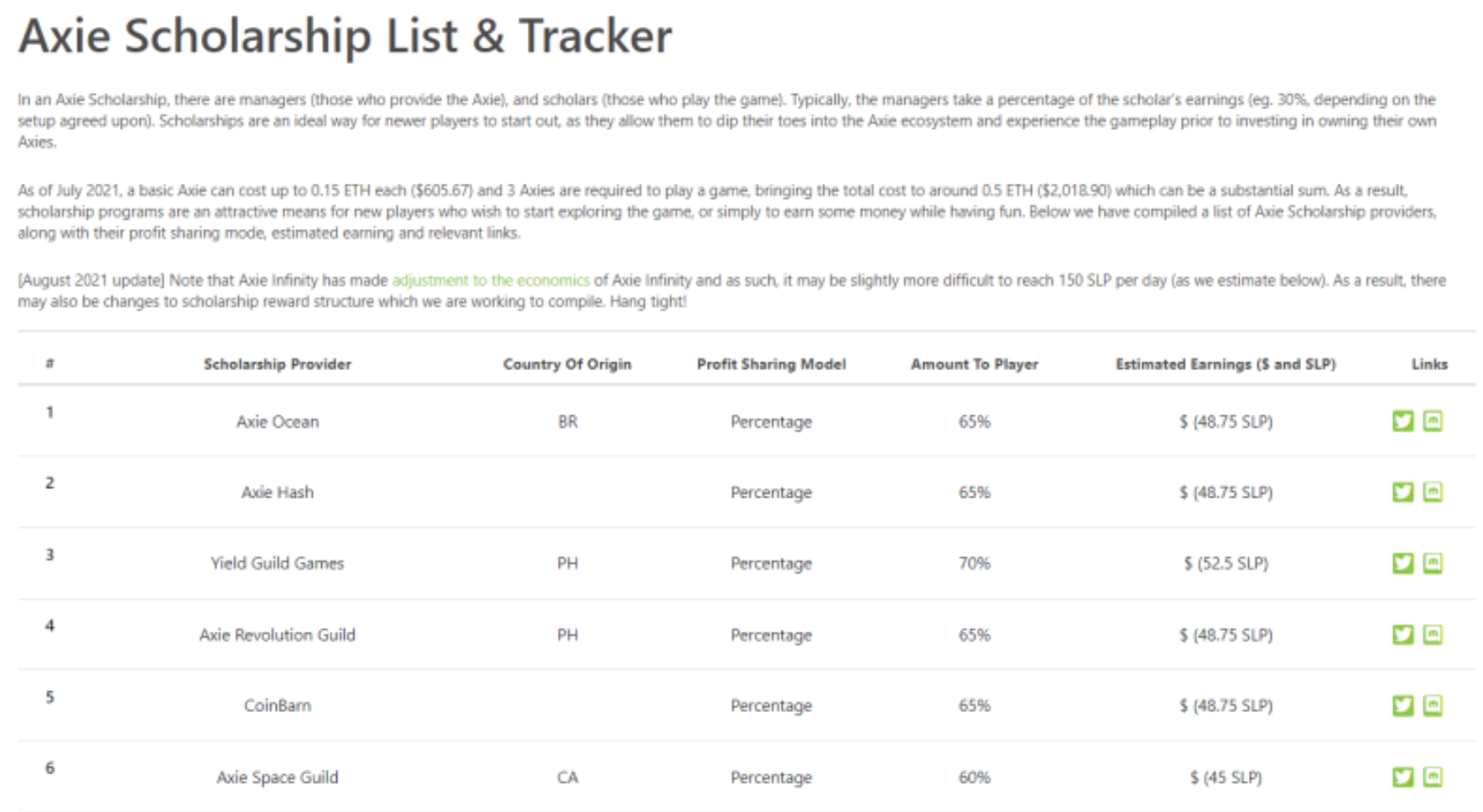
To provide some context, the following is an example of expected benefits for Acra sponsors and trainees. Our assumptions are as follows:
1. The price of SLP will remain at 0.1 USD within 1 year.
2. Upfront fee of $345 per team
3. The price of assets (Axies) remains unchanged within 1 year.

The reason why the crab scholarship is so popular is that it lowers the threshold for playing games. At the same time, investors have also begun to notice the crab economy; there are already dedicatedandandGame guilds (such as Yield Guide Games)Actively invest in the game through the scholarship system. It is only a matter of time before more institutional and private investors start to realize the potential of P2E.
Axie Infinity may be the current P2E leader, but other games are also starting to adopt the P2E model. Technically, any cryptocurrency game with tradable assets can be considered a P2E game. More developers are also aggressively marketing their P2E offerings, especially since their low barriers to entry are aimed at attracting free-to-play (F2P) players.
As more and more players enter the system, each game will have its own virtual economy, driven by the current state of the game and market demand; this is a side effect of the real influence developers have by controlling the laws of the game. This is very similar to the behavior and response of the government, not policies and regulations, but complementary updates as a way to protect the economy.
Many of the games we've discussed in this chapter are very new, and others haven't even launched yet (worth mentioning the discussion below). Even Acra, launched in 2018, is one of the oldest blockchain games and is still in Alpha stage.
P2E has certainly redefined gaming and proven the model to be an effective way to engage players, but whether the in-game economy is sustainable is an entirely different question. The developers are still trying to come up with the right formula. Each game must be judged on its own merits.
worthy of attention
worthy of attention
Star Atlas
Star Atlas is a space-themed strategy game set in the Metaverse of 2620. As in EVE Online, players will have to manage politics, trade routes, and economic production. Every asset in the game is represented in the form of an NFT, which can be found or created by players.
Illuvium
Illuvium is an open world RPG adventure game. As with Pokemon, players can explore the world and capture monsters known as"Illuvials"Mystery pets, these pets are NFT. The gameplay of Illuvium is similar to that of Auto Chess, where battles happen automatically on a board. Players can earn Illuvium (ILV) through games while challenging the leaderboard.
Plants vs Undead
Plants vs Undead (PVU) is a P2E tower defense game on Binance Smart Chain. Similar to the popular Plants vs. Zombies series, players need to use their plant NFTs to fight hordes of undead minions.
R-Planet
R-Planet is a game about crafting and collecting NFTs. Players are motivated to mine and synthesize new elements and grow their collection through a story of space exploration. Native NFTs can also be used to earn the in-game token Aether.
Alien Worlds
Alien Worlds is a resource-based game with an emphasis on governance and mining. Six different factions manage six Odaily. Each faction operates as a DAO, competing with each other to grow their Odaily economy using the in-game token Trilium.
MyNeighbourAlice
in conclusion
in conclusion
The game industry is flourishing in the Internet age. However, over-exploitation and intellectual property rights of developers limit the development of the game economy. The integration of NFTs may not be a new concept, but it could be a medium to support the next generation of games.
Non-blockchain games like Fortnite, Dota 2, and Counter-Strike are examples of free-to-play (F2P) games that rely on"skin"(virtual fashion) and other related peripherals generate profit income. The problem is, players don't technically own these skins. With NFTs, players are free to do what they want with these items.
Additionally, developers can build and integrate existing games with other dApps on the decentralized network, offering a variety of exciting opportunities. For example, two games can cross-cooperate in the game, and even integrate with existing financial dApps to provide players with financial services.
More and more games are beginning to introduce P2E mechanism. Game developers use attractive financial incentives to attract players. However, an excellent P2E economic game is not easy to achieve as the entertainment of the game itself.
While games provide players with entertainment and financial freedom, establishing a balanced flywheel is challenging. The blockchain gaming industry is still in its infancy, but the potential upside and opportunities are endless.
Note: The flywheel effect means that in order to make the stationary flywheel rotate, you must use a lot of strength at the beginning, and push it repeatedly round and round. Every turn is very laborious, but the efforts of each turn will not be in vain. The flywheel will spin faster and faster. (From Baidu Encyclopedia)
As more games start to perfect the token economic formula, we expect more traditional gaming giants to enter the space. We're already starting to see this happening. Companies like EA are currently looking for new hires with experience in NFTs and blockchain games, not to mention EA's CEO has publicly stated that"NFTs are an essential part of the future of our industry"Compilation: Bibabu
Recommended reading:
1、How Gamers are Making a Living: A Case Study on Axie Infinity:https://www.coingecko.com/buzz/how-gamers-are-making-a- living-a-case-study-on-axie-infinity
2、Play-to-Earn: A Study on Scholarship Viability:https://www.coingecko.com/buzz/play-to-earn-a-study-on- scholarship-viability
3、What is Gods Unchained? :https://decrypt.co/48379/gods-unchained-review-and-beginners- guide
4、Cometh Whitepaper:https://www.cometh.io/cometh-white-paper.pdf
By Benjamin Hor, Khor Win Win, Shaun Paul Lee, Dillon Yap, Chin Yi Hong
Published by: CoinGecko
Compilation: Bibabu



